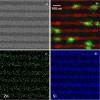Sol-Gel-Deposited Ti-Doped ZnO: Toward Cell Fouling Transparent Conductive Oxides
- PMID: 31460239
- PMCID: PMC6682115
- DOI: 10.1021/acsomega.9b00646
Sol-Gel-Deposited Ti-Doped ZnO: Toward Cell Fouling Transparent Conductive Oxides
Abstract
Ti-doped ZnO thin films were obtained with the aim of tailoring ZnO film bioadhesiveness and making the optoelectronic properties of ZnO materials transferable to biological environments. The films were prepared on silicon substrates by sol-gel spin-coating and subsequent annealing. A Ti-O segregation limits the ZnO crystallite growth and creates a buffer out-layer. Consequently, the Ti-doped ZnO presents slightly increased resistivity, which remains in the order of 10-3 Ω·cm. The strong biochemical interference of Zn2+ ions released from pure ZnO surfaces was evidenced by culturing Staphylococcus epidermidis with and without the Zn2+ coupling agent clioquinol. The Ti-doped ZnO surfaces showed a considerable increase of bacterial viability with respect to pure ZnO. Cell adhesion was assayed with human mesenchymal stem cells (hMSCs). Although hMSCs find difficulties to adhere to the pure ZnO surface, they progressively expand on the surface of ZnO when the Ti doping is increased. A preliminary microdevice has been built on the Si substrate with a ZnO film doped with 5% Ti. A one-dimensional micropattern with a zigzag structure shows the preference of hMSCs for adhesion on Ti-doped ZnO with respect to Si. The induced contrast of surface tension further induces a cell polarization effect on hMSCs. It is suggested that the presence of Ti-O covalent bonding on the doped surfaces provides a much more stable ground for bioadhesion. Such fouling behavior suggests an influence of Ti doping on film bioadhesiveness and sets the starting point for the selection of optimal materials for implantable optoelectronic devices.
Conflict of interest statement
The authors declare no competing financial interest.
Figures








Similar articles
-
Enhanced Electrical Mobilities of Laser Annealed Ga Doped ZnO Thin Films.J Nanosci Nanotechnol. 2020 Jan 1;20(1):520-523. doi: 10.1166/jnn.2020.17266. J Nanosci Nanotechnol. 2020. PMID: 31383203
-
Sol-Gel-Derived Cu-Doped ZnO Thin Films for Optoelectronic Applications.ACS Omega. 2022 Jun 13;7(25):21877-21881. doi: 10.1021/acsomega.2c02040. eCollection 2022 Jun 28. ACS Omega. 2022. PMID: 35785326 Free PMC article.
-
Influence of Dopant Nature on Biological Properties of ZnO Thin-Film Coatings on Ti Alloy Substrate.Nanomaterials (Basel). 2020 Jan 10;10(1):129. doi: 10.3390/nano10010129. Nanomaterials (Basel). 2020. PMID: 31936775 Free PMC article.
-
Various Applications of ZnO Thin Films Obtained by Chemical Routes in the Last Decade.Molecules. 2023 Jun 9;28(12):4674. doi: 10.3390/molecules28124674. Molecules. 2023. PMID: 37375229 Free PMC article. Review.
-
Recent Progress in Solution Processed Aluminum and co-Doped ZnO for Transparent Conductive Oxide Applications.Micromachines (Basel). 2023 Feb 25;14(3):536. doi: 10.3390/mi14030536. Micromachines (Basel). 2023. PMID: 36984942 Free PMC article. Review.
Cited by
-
Preparation and Photocatalytic Performance of Dumbbell Ag2CO3-ZnO Heterojunctions.ACS Omega. 2019 Dec 23;5(1):570-577. doi: 10.1021/acsomega.9b03131. eCollection 2020 Jan 14. ACS Omega. 2019. PMID: 31956804 Free PMC article.
References
-
- Jeong W.-J.; Park G.-C. Electrical and optical properties of ZnO thin film as a function of deposition parameters. Sol. Energy Mater. Sol. Cells 2001, 65, 37–45. 10.1016/s0927-0248(00)00075-1. - DOI
-
- Chen P. H.; Chen Y. A.; Chang L. C.; Lai W. C.; Kuo C. H. Low operation voltage of GaN-based LEDs with Al-doped ZnO upper contact directly on p-type GaN without insert layer. Solid-State Electron. 2015, 109, 29–32. 10.1016/j.sse.2015.02.020. - DOI
-
- Hussain B.; Ebong A.; Ferguson I. Zinc oxide as an active n-layer and antireflection coating for silicon based heterojunction solar cell. Sol. Energy Mater. Sol. Cells 2015, 139, 95–100. 10.1016/j.solmat.2015.03.017. - DOI
-
- Shirahata T.; Kawaharamura T.; Fujita S.; Orita H. Transparent conductive zinc-oxide-based films grown at low temperature by mist chemical vapor deposition. Thin Solid Films 2015, 597, 30–38. 10.1016/j.tsf.2015.11.006. - DOI
LinkOut - more resources
Full Text Sources
Molecular Biology Databases

